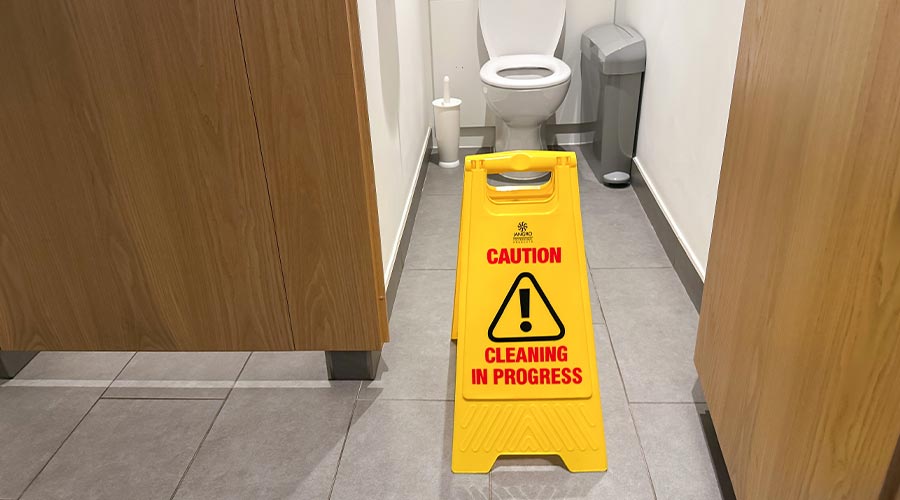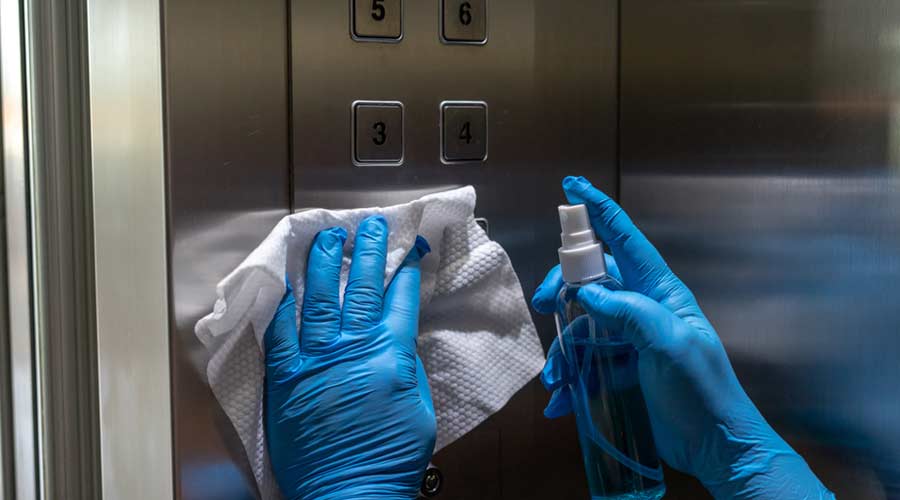
At RCF, Freer explains that for each account, they set up an on-site cleaning closet with chemicals (all prediluted/ready to use), vacuum, trash receptacle, restroom carts, rags, floor cleaning equipment, and any other specific-to-the-site items in order to minimize lost time and damage to equipment expenses.
DeVolder confirms that having supplies on-hand allows cleaning technicians to perform their duties without interruptions caused by product shortages. Service by Medallion uses various technologies to help manage supply inventories. A real-time inventory management program tracks cleaning supplies and equipment as they are used and is updated instantly through digital tools. This system alerts teams to low stock levels, prevents shortages, and supports timely reordering. It also enhances efficiency, reduces waste, and ensures staff always have the resources needed to maintain restroom service quality.
BSCs also rely on specific equipment and chemicals to improve efficiency and effectiveness, as well as meet sustainability directives and goals. Freer says that for larger facilities, they use microfiber mop systems, no-touch restroom cleaning equipment, and pre-measured chemical dispensing systems to avoid waste and enhance accuracy.
“We also utilize hypochlorous acid for safe, effective disinfection as part of our 'Cleaning for the Health of It' program,” she adds.
DeVolder recommends dual-chamber mop buckets to speed up cleaning while maintaining quality; electrostatic sprayers and touchless restroom systems to improve disinfecting coverage and hygiene; and microfiber tools to enhance air quality and cleaning precision.
“On the chemical side, we choose Green Seal-certified cleaning solutions and EPA-registered disinfectants to ensure thorough germ elimination, while neutral floor cleaners protect surfaces during daily use,” she says. “Eco-friendly, certified products offer sustainable options without compromising results, supporting both performance and environmental responsibility.”
Walker's preference is for carts that are designed specifically for restroom service.
“They are sold as all-in-one units and come with everything you need to get started,” he says. “The price point is higher, but simplicity is why you pay the premium, meaning you don’t have to build a different set-up for each building you service.”
He also gives a nod to all-in-one spray-and-vac machines, which he says are great for upselling restroom deep cleans on a monthly basis.
“They get things clean and dry very quickly,” he says. “They’re also really effective for situations where the contract requires regular servicing of large shower bays in locker rooms.”
Restocking and refilling consumable products, such as hand soap and paper towels, also must be done as quickly and efficiently as possible. Berthold sees these tasks as being greatly impacted by the autonomy — or lack thereof — given to BSCs to control what products are used. In some cases, the BSC has full authority to control which dispensers and products are used and is allowed to change them out if necessary to achieve maximum efficiency.
“In other cases, building ownership dictates what is used, leaving the contractor to work around existing 'pinch points' the best they can,” he says.
When given the opportunity to do so, contractors can collaborate with manufacturers to take advantage of newly available dispensers and products that require less refilling and less maintenance over the long haul.
Maintenance Tips
Experts agree that training employees for consistency is the key to successful restroom maintenance. Freer relies on regular (daily, weekly, and monthly) task breakdowns, time-based routines, using the right tools, technology (they utilize software for tracking, task completion, and accountability and on-site printed service schedules for tech-averse staff), proactive inspections and quick-response protocols, and open communication with clients.
At Service by Medallion, DeVolder recognizes that not all restrooms are alike, and that cleaning techniques will vary. It's important to align cleaning schedules with traffic patterns for optimal efficiency, use high-quality tools that help encourage hygiene, implement standardized cleaning procedures to ensure consistency, provide training on proper techniques and safety protocols, utilize real-time inventory management to avoid supply shortages, conduct routine quality assurance checks and gather user feedback to monitor cleanliness and performance, choose eco-friendly products and water-saving equipment to support sustainability goals, and stay current with new technologies and innovations to continuously improve results.
Walker advises that when planning a cleaning strategy, always focus on the staff first. He recommends having a step-by-step process that is clearly articulated. Don’t just train the crew; make sure they understand the importance of restroom cleaning. The work they perform can significantly contribute to positive health outcomes in the indoor environment.
Berthold's perspective is that while there is no single “one size fits all” solution to maximize efficiencies in restroom cleaning, there is a proven formula for working through the variables. Through diligent investment of time and resources, contractors can successfully strike a balance between the perception of clean and the efficacy of cleaning. The result can be a clean environment, satisfied customers, and a healthy bottom line.
Shannon O'Connor is a freelance writer from Mason, Ohio.
Taking Restroom Maintenance to the Next Level

 Celebrating BSCAI's 60th Anniversary eBook
Celebrating BSCAI's 60th Anniversary eBook The Down and Dirty on Cleaning in Virus Season
The Down and Dirty on Cleaning in Virus Season How Surfactant Use is Expanding in Commercial Cleaning
How Surfactant Use is Expanding in Commercial Cleaning